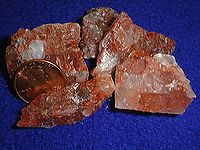
Photo from wikipedia
A sustainable use of locally available wastes from agriculture as supplementary cementitious materials (SCMs) is an alternative solution for the prevention of excessive raw material usage, reduction of CO2 emission… Click to show full abstract
A sustainable use of locally available wastes from agriculture as supplementary cementitious materials (SCMs) is an alternative solution for the prevention of excessive raw material usage, reduction of CO2 emission and cost-effective concrete production. This paper studies the reactivity of non-traditional waste SCMs: Wheat straw ash (WSA), mixture of wheat and soybean straw ash (WSSA) and soybean straw ash (SSA), which are abundant as agricultural by-products in Serbia. The chemical evaluation using XRF technique, thermal analysis (TGA/DSC), XRD and FTIR methods were performed along with physical properties tests to investigate the feasibility of utilizing biomass ashes as cement substitutes. The obtained results demonstrate a high pozzolanic activity of WSA, which is attributed to a high reactive silica content of the ash and its satisfactory level of fineness. A wider hump in XRD pattern of WSA compared to WSSA and SSA confirmed that it abounds in amorphous (reactive) phase. The insufficient activity index of soybean-based biomass ashes, characterized with a low silica content, was improved by additional grinding and/or blending with amorphous silica-rich material. This points out the mechanical activation, i.e., grinding procedure, and chemical activation, i.e., modification of the chemical composition, as techniques efficient at producing pozzolanic materials from biomass wastes. Tested biomass ashes are characterized with negligible leaching values of heavy metals, thereby satisfying eco-friendly principles of SCM utilization. The application of biomass ashes as SCMs leads to substantial cost savings, as well as benefits to the environment, such as lower consumption of cement, reduction of CO2 emissions during the production of cement and sustainable waste management.
Journal Title: Materials
Year Published: 2021
Link to full text (if available)
Share on Social Media: Sign Up to like & get
recommendations!